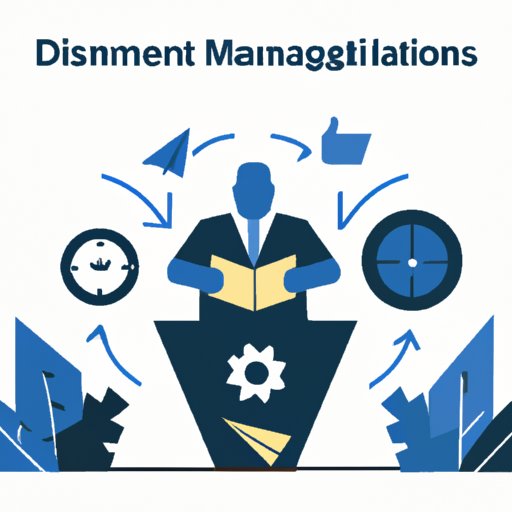Introduction
Decision making is an essential part of successful leadership and management. Leaders and managers are responsible for making decisions that have a direct impact on the success or failure of their organization. Therefore, it is important to understand the role of decision making in leadership and management, as well as the strategies that can be used to improve decision making processes.

Definition of Decision Making in Leadership and Management
Decision making in leadership and management is the process of examining available options, assessing risks, and selecting the best course of action for achieving desired outcomes. It involves gathering and analyzing information, evaluating alternatives, considering consequences, and making decisions that are in the best interest of the organization. Effective decision making requires strong problem-solving skills and the ability to think critically and creatively.

Overview of the Impact of Decision Making on Organizational Performance
Decision making has a significant impact on organizational performance. Poor decisions can lead to costly mistakes and missed opportunities, while well-informed decisions can result in improved efficiency, increased profits, and greater customer satisfaction. Furthermore, good decision making can foster trust and confidence in leaders and managers, which is essential for creating a positive work environment.

Examining the Role of Decision Making in Leadership and Management
Leaders and managers must make decisions on a daily basis, from small operational choices to large strategic initiatives. As such, it is important to understand the benefits of effective decision making and the challenges associated with it.
Exploring the Benefits of Effective Decision Making for Leaders and Managers
Good decision making can have a positive effect on organizational performance and employee morale. Decisions based on data and analysis can help leaders and managers make informed choices that are in the best interest of the organization. Additionally, well-considered decisions can improve efficiency, reduce costs, and increase customer satisfaction. Good decision making also helps to create a culture of trust and respect within the organization, as employees feel more confident in their leaders’ abilities.
Investigating the Challenges of Decision Making in Leadership and Management
Decision making in leadership and management is not always easy. Leaders and managers must often make difficult choices in a short amount of time, with limited resources and incomplete information. Additionally, decisions can have far-reaching implications, both positive and negative, so it is important to weigh the potential risks and rewards carefully. Finally, the pressure of making the “right” decision can lead to analysis paralysis, which can impede progress and stifle innovation.
Analyzing Strategies to Improve Decision Making Processes
In order to make better decisions, leaders and managers should consider the following strategies:
Identifying Common Pitfalls to Avoid
When making decisions, it is important to identify and avoid common pitfalls. These include relying too heavily on intuition, making decisions based on emotions, relying on outdated or inaccurate data, and failing to consider all possible options. Additionally, it is important to recognize when a decision needs to be made quickly and when more time is needed to gather information and analyze options.
Best Practices for Effective Decision Making
Effective decision making requires careful planning and thoughtful consideration. Leaders and managers should identify key stakeholders and involve them in the decision-making process. Additionally, they should use data and analysis to inform their decisions and consider all potential outcomes. Leaders and managers should also take the time to evaluate their decisions and adjust their approach if necessary.
Utilizing Technology to Streamline Decision Making Processes
Technology can be used to streamline decision making processes. Tools such as spreadsheets and project management software can be used to organize data, track progress, and monitor results. Additionally, artificial intelligence and machine learning can provide insights and predictions that can help leaders and managers make better decisions.
Applying Decision Making Theory to Real-World Scenarios
It is one thing to understand the theoretical aspects of decision making, but it is another to apply those principles to real-world scenarios. The following case studies and examples illustrate the importance of effective decision making in leadership and management.
Case Studies of Successful Decision Making
One example of successful decision making is the turnaround of a struggling company. In this case, the CEO identified key areas of improvement and implemented changes that led to increased profits and improved customer satisfaction. Another example is a company that successfully navigated a period of rapid growth by leveraging the strengths of its team and making strategic investments in technology and infrastructure.
Examples of Poor Decisions and their Consequences
Poor decisions can have serious consequences. For example, a company that fails to invest in new technologies may miss out on potential opportunities. Another example is a company that makes decisions based on short-term gains rather than long-term goals, resulting in decreased profits and customer dissatisfaction.
Conclusion
Decision making is a critical component of successful leadership and management. The ability to make well-informed decisions can have a positive impact on organizational performance and employee morale. Leaders and managers should strive to identify common pitfalls and use best practices for effective decision making. Additionally, they should consider utilizing technology to streamline decision making processes. By applying decision making theory to real-world scenarios, leaders and managers can gain valuable insights into the importance of making sound decisions.
(Note: Is this article not meeting your expectations? Do you have knowledge or insights to share? Unlock new opportunities and expand your reach by joining our authors team. Click Registration to join us and share your expertise with our readers.)
